(Press-News.org) High in a narrow, seawater-filled crevasse in the base of Antarctica’s largest ice shelf, cameras on the remotely operated Icefin underwater vehicle relayed a sudden change in scenery.
Walls of smooth, cloudy meteoric ice suddenly turned green and rougher in texture, transitioning to salty marine ice.
Nearly 1,900 feet above, near where the surface of the Ross Ice Shelf meets Kamb Ice Stream, a U.S.-New Zealand research team recognized the shift as evidence of “ice pumping” – a process never before directly observed in an ice shelf crevasse, important to its stability.
“We were looking at ice that had just melted less than 100 feet below, flowed up into the crevasse and then refrozen,” said Justin Lawrence, visiting scholar at the Cornell Center for Astrophysics and Planetary Science. “And then it just got weirder as we went higher up.”
The Icefin robot’s unprecedented look inside a crevasse, and observations revealing more than a century of geological processes beneath the ice shelf, are detailed in “Crevasse Refreezing and Signatures of Retreat Observed at Kamb Ice Stream Grounding Zone,” published March 2 in Nature Geoscience.
The paper reports results from a 2019 field campaign to Kamb Ice Stream supported by Antarctica New Zealand and other New Zealand research agencies, led by Christina Hulbe, professor at the University of Otago, and colleagues. Through support from NASA’s Astrobiology Program, a research team led by Britney Schmidt, associate professor of astronomy and earth and atmospheric sciences at Cornell University, was able to join the expedition and deploy Icefin. Schmidt’s Planetary Habitability and Technology Lab has been developing Icefin for nearly a decade, beginning at the Georgia Institute of Technology.
Combined with recently published investigations of the fast-changing Thwaites Glacier – explored the same season by a second Icefin vehicle – the research is expected to improve models of sea-level rise by providing the first high-resolution views of ice, ocean and sea floor interactions at contrasting glacier systems on the West Antarctic Ice Sheet.
Thwaites, which is exposed to warm ocean currents, is one of the continent’s most unstable glaciers. Kamb Ice Stream, where the ocean is very cold, has been stagnant since the late 1800s. Kamb currently offsets some of the ice loss from western Antarctica, but if it reactivates could increase the region’s contribution to sea-level rise by 12%.
“Antarctica is a complex system and it’s important to understand both ends of the spectrum – systems already undergoing rapid change as well as those quieter systems where future change poses a risk,” Schmidt said. “Observing Kamb and Thwaites together helps us learn more.”
NASA funded Icefin’s development and the Kamb exploration to extend ocean exploration beyond Earth. Marine ice like that found in the crevasse may be an analog for conditions on Jupiter’s icy moon Europa, the target of NASA’s Europa Clipper orbital mission slated for launch in 2024. Later lander missions might one day search directly for microbial life in the ice.
Icefin carries a full complement of oceanographic instruments on a modular frame more than 12 feet long and less than 10 inches in diameter. It was lowered on a tether through a borehole the New Zealand team drilled through the ice shelf with hot water.
During three dives spanning more than three miles near the grounding zone where Kamb transitions to the floating Ross shelf, Icefin mapped five crevasses – ascending one – and the sea floor, while recording water conditions including temperature, pressure and salinity.
The team observed diverse ice features that provide valuable information about water mixing and melt rates. They included golf ball-like dimples, ripples, vertical runnels and the “weirder” formations near the top of the crevasse: globs of ice and finger-like protrusions resembling brinicles.
Ice pumping observed in the crevasse likely contributes to the relative stability of the Ross Ice Shelf – the world’s largest by area, the size of France – compared to Thwaites Glacier, the researchers said.
“It’s a way these big ice shelves can protect and heal themselves,” said Peter Washam, a polar oceanographer on the Icefin science team and the paper’s second author. “A lot of the melting that happens deep near the grounding line, that water then refreezes and accretes onto the bottom of the ice as marine ice.”
On the sea floor, Icefin mapped parallel sets of ridges that the researchers believe are impressions left behind by ice shelf crevasses – and a record of 150 years of activity since the Kamb stream stagnated. As its grounding line retreated, the ice shelf thinned, causing the crevasses to lift away. The ice’s slow movement over time shifted the crevasses seaward of the ridges.
“We can look at those sea floor features and directly connect them to what we saw on the ice base,” said Lawrence, the paper’s lead author, now a program manager and planetary scientist at Honeybee Robotics. “We can, in a way, rewind the process.”
In addition to Lawrence, Washam and Schmidt, Cornell co-authors of the research are Senior Research Engineers Matthew Meister, who led the Icefin engineering team, and Andrew Mullen; Research Engineer Daniel Dichek; and Program Manager Enrica Quartini. Schmidt’s team also includes Research Engineer Frances Bryson, and at Georgia Tech, doctoral students Benjamin Hurwitz and Anthony Spears.
Also contributing were partners from New Zealand at the National Institute of Water and Atmospheric Research (NIWA); University of Auckland; University of Otago; and Victoria University of Wellington.
NASA supported the research through the Planetary Science and Technology from Analog Research program’s Project RISE UP (Ross Ice Shelf and Europa Underwater Probe), and the Future Investigators in NASA Earth and Space Science and Technology program. Additional support came from New Zealand’s Antarctic Science Platform, the U.S. Antarctic Program and Victoria University of Wellington’s Hot Water Drilling initiative.
END
Robot provides unprecedented views below Antarctic ice shelf
2023-03-02
ELSE PRESS RELEASES FROM THIS DATE:
New MIT Sloan research finds Americans are more receptive to counter-partisan messages than previously thought
2023-03-02
Party loyalty and partisan motivation may interfere less with Americans’ thinking than previously believed, MIT behavioral researchers Ben M. Tappin, Adam J. Berinsky, and David G. Rand report in new research published in the journal Nature Human Behaviour.
The study, which looked at how Democrats and Republicans react to persuasive messaging that doesn't align with their party leader’s position, challenges the view that party loyalty distorts how Americans process evidence and arguments.
“Our results are clear and unequivocal: Learning the in-party leader’s ...
Wisconsin cave holds tantalizing clues to ancient climate changes, future shifts
2023-03-02
Even in their dark isolation from the atmosphere above, caves can hold a rich archive of local climate conditions and how they've shifted over the eons. Formed over tens of thousands of years, speleothems — rock formations unique to caves better known as stalagmites and stalactites — hold secrets to the ancient environments from which they formed.
A newly published study of a stalagmite found in a cave in southern Wisconsin reveals previously undetected history of the local climate going back thousands of years. The new findings provide strong ...
Getting drugs across the blood-brain barrier using nanoparticles
2023-03-02
• The blood-brain barrier prevents most drugs from reaching brain tumors.
• A new method using nanoparticles transported drugs across this barrier in mice.
• The nanoparticles target a protein on tumor blood vessel cells called P-selectin.
• The nanoparticles improved the treatment in a model of aggressive pediatric brain cancer
Brain tumors are notoriously hard to treat. One reason is the challenge posed by the blood-brain barrier, a network of blood vessels and tissue with closely spaced cells. The barrier forms a tight seal to protect ...
Insights into the evolution of the sense of fairness
2023-03-02
Göttingen, March 2, 2023. A sense of fairness has long been considered purely human – but animals also react with frustration when they are treated unequally by a person. For instance, a well-known video shows monkeys throwing the offered cucumber at their trainer when a conspecific receives sweet grapes as a reward for the same task. Meanwhile, researchers have observed similarly frustrated reactions to unfair rewards in wolves, rats and crows. However, researchers still debate the reasons for this behavior: Does the frustration really stem from a dislike of unequal treatment, or is there another explanation? In a study with long-tailed ...
Security vulnerabilities detected in drones made by DJI
2023-03-02
Researchers from Bochum and Saarbrücken have detected security vulnerabilities, some of them serious, in several drones made by the manufacturer DJI. These enable users, for example, to change a drone’s serial number or override the mechanisms that allow security authorities to track the drones and their pilots. In special attack scenarios, the drones can even be brought down remotely in flight.
The team headed by Nico Schiller of the Horst Görtz Institute for IT Security at Ruhr University Bochum, ...
Coastal water pollution transfers to the air in sea spray aerosol and reaches people on land
2023-03-02
New research led by Scripps Institution of Oceanography at UC San Diego has confirmed that coastal water pollution transfers to the atmosphere in sea spray aerosol, which can reach people beyond just beachgoers, surfers, and swimmers.
Rainfall in the US-Mexico border region causes complications for wastewater treatment and results in untreated sewage being diverted into the Tijuana River and flowing into the ocean in south Imperial Beach. This input of contaminated water has caused chronic coastal water pollution in Imperial ...
A bridge between hydrophobicity and hydrophilicity of flax fiber: A breakthrough in the multipurpose oil-water separation field
2023-03-02
The large number of oily wastewater discharges and oil spills are bringing about severe threats to environment and human health. Corresponding to this challenge, a number of functional materials have been developed and applied in oil-water separation as oil barriers or oil sorbents. These materials can be divided into two main categories which are artificial and natural.
Natural materials such as green bio-materials are generally low cost and abundant with biological degradability, which are also regarded as promising alternatives for oil-water separation ...
CityU scholars unify color systems using prime numbers
2023-03-02
Existing colour systems, such as RGB and CYMK, are all text-based and require a large range of values to represent different colours, making them difficult to compute and time-consuming to convert. Recently, researchers from City University of Hong Kong (CityU) made a breakthrough by inventing an innovative colour system, called “C235”, based on prime numbers, enabling efficient encoding and effective colour compression. It can unify existing colour systems and has the potential to be applied in various applications, like designing an energy-saving LCD system and colourizing DNA codons.
Currently, ...
UCD Archaeologist receives prestigious Dan David Prize for research on the invisible workforce behind ancient forms of art
2023-03-02
The Dan David Prize, the largest history prize in the world, has announced University College Dublin (UCD) Archaeologist, Dr Anita Radini, as one of nine recipients for 2023.
Each of the winners - who work in Kenya, Denmark, Israel, Canada, the US and Ireland - will receive $300,000 (USD) in recognition of their achievements as emerging scholars and to support their future endeavours in the study of the human past. Dr Radini is the first in Ireland to receive this award.
“Our winners represent the next generation of historians,” said Ariel ...
Putting a price tag on the amenity value of private forests
2023-03-02
When it comes to venturing into and enjoying nature, forests are the people’s top choice – at least in Denmark. This is also reflected in the sales prices of properties with private forest. But beyond earnings potential, this first study of its kind, conducted by the University of Copenhagen, puts a price tag on the so-called amenity value of Danish private forests.
Forests have a nearly therapeutic effect on humans. Perhaps that is why eight out of ten of Danes have wandered in the woods over ...







